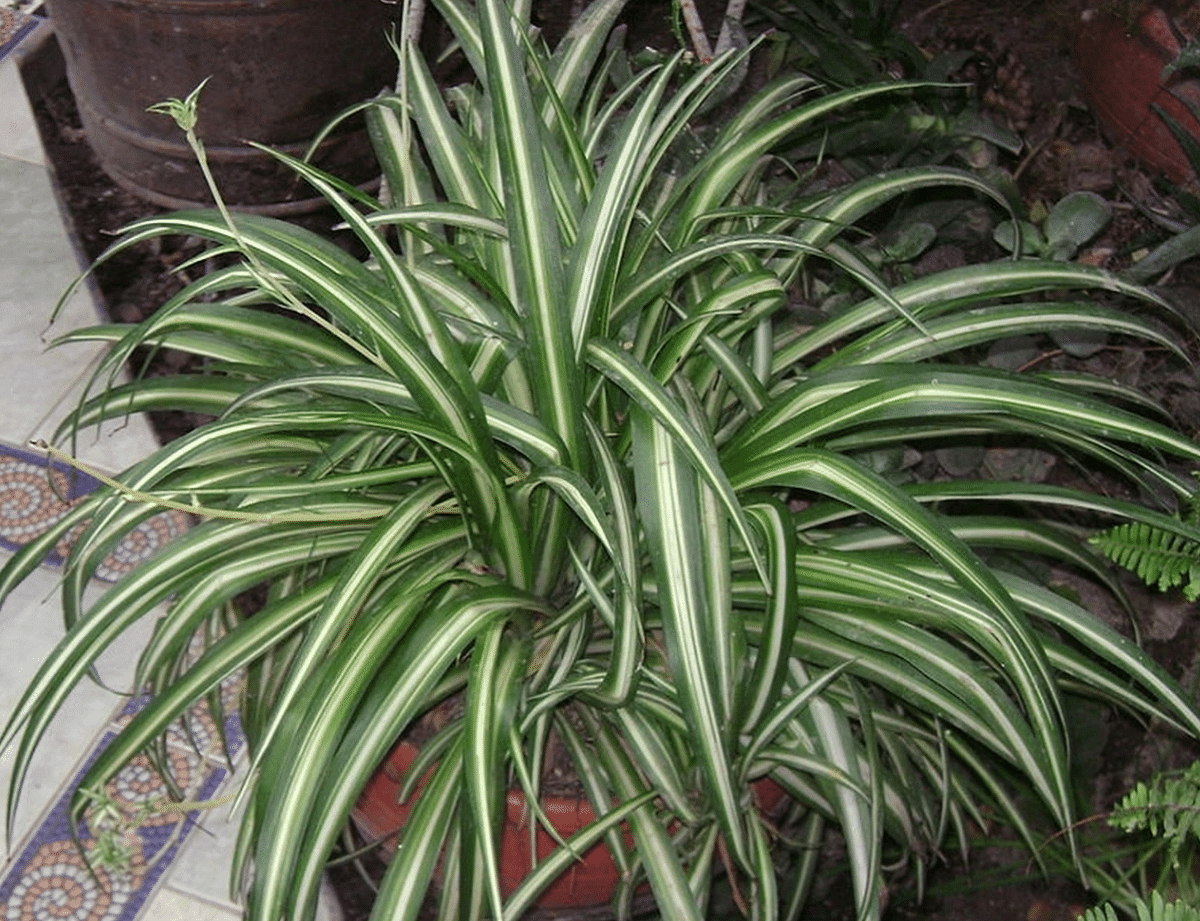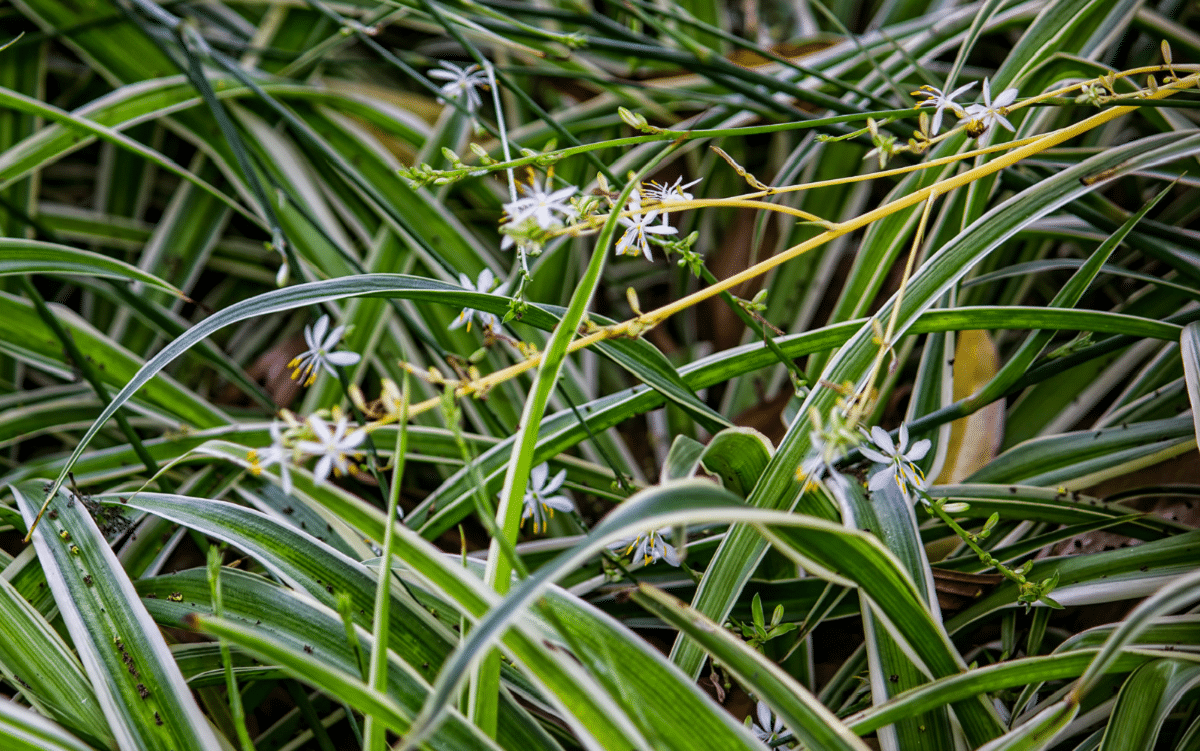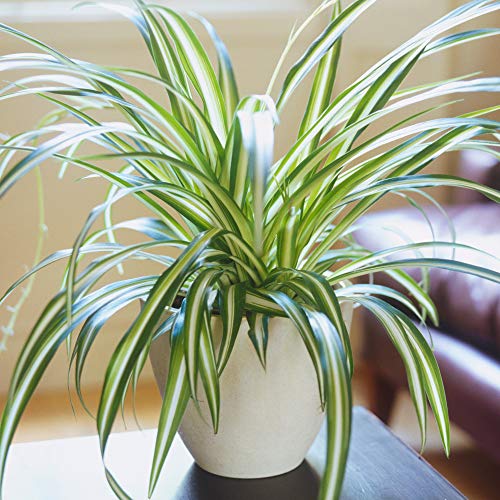
The bad mother plant is one of those that most decorate the homes of our elders, and this is so for a very important reason: it is very, very easy to care for. With a little water and light, it lives for several years at home, and it can even do it outside if the climate is not very cold.
For this reason, If you don't have much experience with plants or would like to start off on the right foot, the bad mother plant is your best option., since we are also going to tell you everything you must do to keep it perfect.
General data of the bad mother
The first thing you have to know is that it is a plant whose scientific name is Chlorophytum and in a common way it is known as a bad mother, bonds of love or tape in some parts of the world because of the appearance of the leaves of this plant.
Regarding the data that identify this species, we find that it belongs to the kingdom of the Plantae and is within the Asparagaceae family. It is worth mentioning that there are many variants of this genus of plants, but the vast majority have the same peculiarity in their leaves as they are elongated.
On the other hand, it is important to mention that you know that it is a plant whose origin is in southern Africa and currently has managed to have a worldwide expansion, so it is not uncommon to find them in the United States, Europe and even in Latin America.
In fact, it is in Latin America where its popularity in homes is greater than in any other part of the world.
Identifying that it is a bad mother is quite simple thanks to the fact that has extremely long and thin leaves. These tend to arch and often have a kind of yellowish-white stripe right in the middle from start to finish.
Main known species
Currently there are around 250 different species of Chlorophytum. But among all of them, the ones that stand out the most are the following that we will mention.
Chlorophytum comosum
It is also known by the name of Chlorophytum capense. It is a variation whose leaves can reach a length of up to 30 cm. These usually develop in the form of rosettes with leaves, which ends up giving the characteristic shape to the plant.
A curious fact about this species is that once it produces white flowers, after a while the petals fall off. What you do not know is that when this happens and falls right on the ground, this will cause new and small seedlings to be created that will be and they can be used to multiply the plant more easily.
Want a? Buy it here.
Chlorophytum laxum
This species has its origin in two parts of the world, the first of them is in Ghana and the other in Northern Nigeria. It is a plant whose dimensions are much smaller than any other variation of this species and the color of the leaves has a bright green hue, although it still maintains that whitish color on the edges.
Chlorophytum undulatum
This is one of the variants that originated in southern Africa and has managed to reach more territory than is believed in other parts of the world. In this case, it is a species whose leaves are narrower and harder.
And as far as the flowers are concerned, these develop as if they were spikes and also maintain the white color as in the other variations, however, they can turn a dark red color on some occasions.
General care
Water it often ... but without overdoing it
The bad mother plant is one of those plants that, although it is necessary to water regularly to prevent it from drying out, does not tolerate waterlogging. In fact, it is often die from too much water, since in addition, since a plate is usually placed under it, the roots are in direct contact with the precious element, which will do a lot of damage.
For this reason, it is necessary to water 3-4 times a week during the warmer months and every 5 or 6 days the rest of the year, and always bearing in mind that the water is removed from the dish ten minutes after watering.
Fertilize it as it grows
All plants need 'food' while they are growing, including our protagonist. Even though can live relatively well on substrate nutrients alone, it will do much more and better if it is paid in spring and summer.
For this reason it is highly recommended to use an organic compost that is of rapid effectiveness, such as guano in liquid form. By following the instructions specified on the product packaging, you will be able to have a beautiful and very healthy plant. Now, we also recommend using a fertilizer for green plants from time to time, such as this.
Change the pot
Although it is the last thing we usually agree on, it is very important to do so. The bad mother plant is true that it is small and that it does not take up too much space, but over time your root system fills the entire pot, thus expending all the nutrients that are in it until there comes a time when growth stops.
To avoid this, it should be transplanted at least every 3 springs.
Should the bad mother be pruned or not?
You may feel the need to prune the plant when it has reached a considerable size. Nevertheless, this is one of those species that does not require pruning nor should you do it.
You just have to wait for the leaves to dry on their own and then you just have to remove them very carefully and without damaging them. What's more, the last thing that we just mentioned is of the utmost importance that you do it, since if you don't, the plant will begin to attract pests and diseases that quickly damage it.
Multiplication
The good thing about this species is that can be multiplied in different waysYou can either opt for multiplication by seeds or by rooting parts of the plant. Moreover, this last method is the most used, but what few know about this plant is that it has an additional form of multiplication which is by division.
Multiplication by sheets
To opt for this type of multiplication, you have to use the bad stem leaves that develop right in the center of the rosette. It is easy to identify them because it tends to have a fairly fleshy, white stem.
In the case of using this method, know that just cut the stems and then plant them in a separate pot, or even on the same ground directly. Of course, it has to be placed in a place where it has enough shade and until the plant has developed enough to move it.
Multiplication by division
This is a method that is essentially quite simple to use. The good thing is that the plant itself tends to grow quite fast and using this method is the most viable option for many.
All you have to do is take the plant carefully and remove it from the pot or remove it from the ground if you have it in that place. Then very carefully you separate it until you have two halves of the same plant. You can proceed to plant them in separate pots or not. It is up to your free choice.
Multiplication by seeds
This is no longer news to anyone, since it is a method known to everyone in any part of the world. However, if you are going to opt for this method, know that you have to do it only in early spring.

Enjoy your tape.






I have had such a plant for almost 30 years and I am renewing it with its youngsters, but when I transplanted it, it removed those roots that it looks like bulbous. I do not know if I'm doing right. What dou you recommend?
Hello Teresa.
Well, it's a bit the same hehe 🙂 From those thicker roots new leaves will sprout (suckers). If you do not want the plant to be larger, you do well to remove them.
A greeting.
Very interesting I have several kalanchoes and cactud
Hi Elida.
We are glad to know that you found it interesting 🙂
Greetings.
I love this plant, I have one for 25 years and I have made hundreds of children and I have given a lot, not if this is the original, because it mixes with the children.
This plant is a child, of children of children of children of many children in turn of one that was bought in a flower shop in 78. That is why it is so important to us
Enjoy it 🙂
Thanks a lot. Very interesting information. It helps me a lot.
We are glad to have helped you, Marilúka 🙂
Good to know !!! Thanks!! I have one a few years ago, never change it pot. I did not know how to take care of it, I only watered it regularly this pretty one and with dangling children I am going to change the pot. Thanks!!!
Thank you. We are glad to know that it has been useful to you 🙂
The bond of love, I did not care when I was in a relationship. Being alone she was radiant. Why?
Hi Nesly.
It is possible that your partner at the time watered it more than he needed. This is a plant that wants water a lot, but if you add too much, its roots rot.
Greetings.
I had it twice, it seems beautiful to me. I had no luck, both times it died even when I put it with indirect light, the second time I put it outside on the terrace, I was not lucky either. I have read your instructions on how to water it and I have done so. I will try again later, that plant is beautiful, I adore plants
Hello Sandra.
The bad mother plant is one that you don't have to pay much attention to. Shadow, a watering from time to time and that's it. Of course, if you have it indoors, it must be away from drafts.
Luck for the next!
It is a beautiful and attractive plant that is very valuable for its health benefits, but if it is watered a lot it is damaged!
Hi Celina.
Yes, we agree. You have to water it in moderation 🙂
Regards!
I have a small apartment and I like these plants, I try to take care of them as much as possible I will follow their recommendations I love them a lot and I have others all in pots. thanks for your comments. I will follow her on Pinterest.es where I am subscribed I am Panamanian. I'll enter here too. Greetings from my beautiful Panama- I am Francis.
Hi Francis.
Thanks for following us. We hope you like the blog.
regards
Hello, I have the bad mother plant in my house because they gave me a pot, I already changed the pot and water it sparingly but I don't understand why its leaves dry out quickly or they look as if they were burned from the tips.
Greetings from Mexico
Hi Josselin.
Can it be that the sun hits him at some point? Even if you have it indoors, if it is by the window it is better to move it away from there.
Also, if you have a plate under it, you have to drain the water so it does not rot.
Regards!
Hello, I have doubts if this plant is the same as the Kalanchoe to which anti-cancer properties are attributed
Hello Ian.
Sorry, I didn't understand you. The bad mother plant and the Kalanchoe they are two totally different plants.
I would say that the bad mother plant does not have anti-cancer properties. I have not found anything about it.
Greetings.